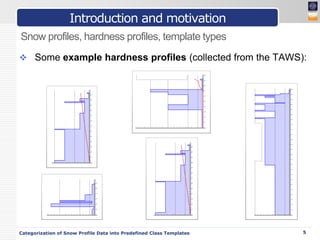Categorization of Snow Profile Data into Predefined Class Templates
- 1. Leopold-Franzens-University Innsbruck Institute of Computer Science Categorization of Snow Profile Data into Predefined Class Templates MASTER THESIS Christian Schaiter Academic advisors: Univ.-Prof. Dr. G├╝nther Specht DI Robert Binna
- 2. Content What you may expect in the next 15 minutes... 1 Introduction and motivation 2 Overview of the developed system 3 Alignment of hardness profiles 4 Conclusion Categorization of Snow Profile Data into Predefined Class Templates 2
- 3. Overview Current chapter: Introduction 1 Introduction and motivation 2 Overview of the developed system 3 Alignment of hardness profiles 4 Conclusion Categorization of Snow Profile Data into Predefined Class Templates 2
- 4. Introduction and motivation Aim of the thesis ’üČ Master thesis was done in cooperation with the Tyrolean avalanche warning service (TAWS) ’üČ Goal: Find a way to determine the potential magnitude of an avalanche Categorization of Snow Profile Data into Predefined Class Templates 3
- 5. Introduction and motivation Snow profiles, hardness profiles, template types ’üČ TAWS frequently takes snow profiles from different areas ’üČ Most relevant property of a snow profile for this thesis: Hardness profile Hardness profile Snow height [cm] ’é¦ Snow hardness Categorization of Snow Profile Data into Predefined Class Templates 4
- 6. Introduction and motivation Snow profiles, hardness profiles, template types ’üČ Some example hardness profiles (collected from the TAWS): Categorization of Snow Profile Data into Predefined Class Templates 5
- 7. Introduction and motivation Snow profiles, hardness profiles, template types ’üČ Idea: Introduce a group of predefined hardness profile types (template types, class templates) ’üČ These template types describe the overall composition of the snowpack ’üČ They may be used to Profile types (class templates) estimate the magnitude of avalanches ’üČ 10 types defined so far Categorization of Snow Profile Data into Predefined Class Templates 6
- 8. Introduction and motivation Snow profiles, hardness profiles, template types ’üČ Goal: Automatically find the associated profile type for each collected hardness profile ’é¦ Reject hardness profile if no reasonable profile type is found Profile types (class templates) Snow height [cm] Hardness profile Determine type Snow hardness Categorization of Snow Profile Data into Predefined Class Templates 7
- 9. Overview Current chapter: Overview of the developed system 1 Introduction and motivation 2 Overview of the developed system 3 Alignment of hardness profiles 4 Conclusion Categorization of Snow Profile Data into Predefined Class Templates 8
- 10. Overview of the developed system Schematic view of the proposed classification system Categorization of Snow Profile Data into Predefined Class Templates 9
- 11. Overview Current chapter: Alignment of hardness profiles 1 Introduction and motivation 2 Overview of the developed system 3 Alignment of hardness profiles 4 Conclusion Categorization of Snow Profile Data into Predefined Class Templates 10
- 12. Alignment of hardness profiles Representation format of hardness profiles ’üČ Hardness profiles may be viewed as time series (clockwise rotated by 90┬░) ’é¦ Height corresponds to time axis ’é¦ Hardness values map to the amplitude dimension ’üČ Desired properties of an internal data format: ’é¦ Height independence ’é¦ Shape preservation ’é¦ 90┬░ Local height warping Categorization of Snow Profile Data into Predefined Class Templates 11
- 13. Alignment of hardness profiles Representation format of hardness profiles ’üČ Hardness profiles may be viewed as time series (clockwise rotated by 90┬░) ’é¦ Height corresponds to time axis ’é¦ Hardness values map to the amplitude dimension ’üČ Desired properties of an internal data format: ’é¦ Height independence ’é¦ Shape preservation ’é¦ Local height warping Categorization of Snow Profile Data into Predefined Class Templates matching 11
- 14. Alignment of hardness profiles Hardness profiles as weighted strings ’üČ Idea: Use symbolic representation (weighted strings) ’üČ A weighted string is composed of weighted characters ’é¦ Direction character: D (down), U (up) ’é¦ Height (as a percentage) 6 5 4 3 2 1 ’üČ Hardness difference (among adjacent layers) Compact form uses only direction characters D ’Ć©D, 0.15, ’ĆŁ 1.5’Ć® ’Ć©U, 0.05, 3.5’Ć® D U ’Ć©D, 0.35, ’ĆŁ 0.5’Ć® D ’Ć©D, 0.1, ’ĆŁ 1’Ć® ’Ć©D, 0.05, ’ĆŁ 3’Ć® ’Ć©U, 0.1, 6’Ć® ’é¦ ’Ć©D, 0.05, ’ĆŁ 1.5’Ć® ’Ć©D, 0.15, ’ĆŁ 1’Ć® D D U Categorization of Snow Profile Data into Predefined Class Templates D 12
- 15. Alignment of hardness profiles Principle of hardness profile alignment ’üČ Hardness profiles are aligned based on their compact strings ’é¦ Weights are required to calculate a penalty score ’üČ Goal: Find a global alignment with a maximum number of matching characters (optimal alignment) ’üČ Edit transcript describes operations (match M, deletion D, insertion I) required to transform the first string into the second String alignment examples ’é¦ The compact string UUDUD and DUDUU may be aligned as ŌĆō U U D ŌĆō U D D ŌĆō U D U U ŌĆō I D M M I M D or U U D U D ŌĆō ŌĆō ŌĆō ŌĆō D U D U U , etc D D M M M I I Categorization of Snow Profile Data into Predefined Class Templates 13
- 16. Alignment of hardness profiles Principle of hardness profile alignment Well-matching profile U D D ŌĆō U U D D D U D D D ŌĆō U D D D M M M I D M M M M Categorization of Snow Profile Data into Predefined Class Templates Badly-matching profile U D D U U D D D U ŌĆō D ŌĆō ŌĆō ŌĆō ŌĆō ŌĆō M D M D D D D D 14
- 17. Alignment of hardness profiles Calculation of optimal alignments ’üČ Algorithms for calculating optimal string alignments: Categorization of Snow Profile Data into Predefined Class Templates 15
- 18. Alignment of hardness profiles Calculation of optimal alignments Categorization of Snow Profile Data into Predefined Class Templates 16
- 19. Alignment of hardness profiles Computation of penalty scores ’üČ After all optimal alignments have been found: Compute penalty scores ’üČ 2 types of penalties: ’é¦ Match-penalty for differences in: - Height - Hardness ’é¦ Mismatch-penalty for mismatching blocks - Much more severe Categorization of Snow Profile Data into Predefined Class Templates match-penalty 17
- 20. Overview Current chapter: Conclusion 1 Introduction and motivation 2 Overview of the developed system 3 Alignment of hardness profiles 4 Conclusion Intrusion Detection Systems for SOA 18
- 21. Conclusion What you have heard in the last 15 minutes ’üČ Template types are used to estimate magnitude of avalanches ’üČ Classification is based on string alignment techniques ’üČ Well matching strings similar hardness profiles ’üČ Achieved success rate of > 90% for example set (if not rejected) ’üČ Approach may be used for any time series data Categorization of Snow Profile Data into Predefined Class Templates 19
- 22. Thank you for your attention! Any Question?
- 23. Backup slides Distance measures: Cosine of angle, Euclidean Distance ’üČ Similarity measure: Cosine of angle ’üČ Dissimilarity measure: Euclidean Distance Euclidean Distance: Take the smallest distance between points in the vector space Categorization of Snow Profile Data into Predefined Class Templates Cosine of angle: Take the smallest angle between vectors 21
- 24. Backup slides Problems with the Euclidean Distance ’üČ Consider the hardness profile (in blue) and its dedicated template (in green) ’üČ In principle they are well-matching ’üČ Nevertheless, a large error occurs (in red) when applying the Euclidean Distance measure ’üČ ED does not handle ŌĆ£height warpsŌĆØ Categorization of Snow Profile Data into Predefined Class Templates 22
- 25. Backup slides Calculation of optimal alignments ’üČ Compute a distance table (with dynamic programming) ’é¦ Example: Compact strings UUDUD and DUDUU Categorization of Snow Profile Data into Predefined Class Templates 23
- 26. Backup slides Calculation of optimal alignments ’üČ Based on the distance table, compute the edit graph and perform a traceback U U D U D ŌĆō ŌĆō ŌĆō ŌĆō D U D U U D D M M M I I ŌĆō U U D ŌĆō U D D ŌĆō U D U U ŌĆō I D M M I M D Categorization of Snow Profile Data into Predefined Class Templates 24
- 27. Backup slides Template type duplication ’üČ Template type versioning: ’é¦ Create different versions with multiple gradation steps Categorization of Snow Profile Data into Predefined Class Templates 25
- 28. Backup slides Template type duplication ’üČ Variations of template type versions: ’é¦ Scale up one layer at the cost of the other layers Categorization of Snow Profile Data into Predefined Class Templates 26
- 29. Backup slides Profile matching ’üČ Alignment of hardness layers: Limitations ’é¦ Example should be of type 4, but perfectly matches type 3 Categorization of Snow Profile Data into Predefined Class Templates 27
- 30. Backup slides Profile matching ’üČ Alignment of hardness layers: Limitations ’é¦ Problem of deceptive local extremes ’é¦ Causing false negatives badly matching perfect match Categorization of Snow Profile Data into Predefined Class Templates 28
- 31. Backup slides Profile matching ’üČ Alignment of hardness layers: Limitations ’é¦ Problem of abusing misalignments ’é¦ Causing false positives ’é¦ Apparently wrong profiles may achieve too good penalty scores (see examples) Categorization of Snow Profile Data into Predefined Class Templates 29
- 32. Backup slides Genetic Algorithm principles ’üČ Mechanics of a simple Genetic Algorithm: 5 Steps ’é¦ Step I: Encoding of the search domain with a small alphabet ’é¦ Step II: Creation of an initial string population ’é¦ Step III: Reproduction of strings ’é¦ Step IV: Crossover of strings ’é¦ Step V: Mutation of strings Categorization of Snow Profile Data into Predefined Class Templates 30





![Introduction and motivation
Snow profiles, hardness profiles, template types
’üČ TAWS frequently takes snow profiles from different areas
’üČ Most relevant property of a snow profile for this thesis:
Hardness profile
Hardness
profile
Snow height [cm]
’é¦
Snow hardness
Categorization of Snow Profile Data into Predefined Class Templates
4](https://image.slidesharecdn.com/defensiopresentation-131102065938-phpapp02/85/Categorization-of-Snow-Profile-Data-into-Predefined-Class-Templates-5-320.jpg)


![Introduction and motivation
Snow profiles, hardness profiles, template types
’üČ Goal: Automatically find the associated profile type for
each collected hardness profile
’é¦
Reject hardness profile if no reasonable profile type is found
Profile types (class templates)
Snow height [cm]
Hardness profile
Determine type
Snow hardness
Categorization of Snow Profile Data into Predefined Class Templates
7](https://image.slidesharecdn.com/defensiopresentation-131102065938-phpapp02/85/Categorization-of-Snow-Profile-Data-into-Predefined-Class-Templates-8-320.jpg)























